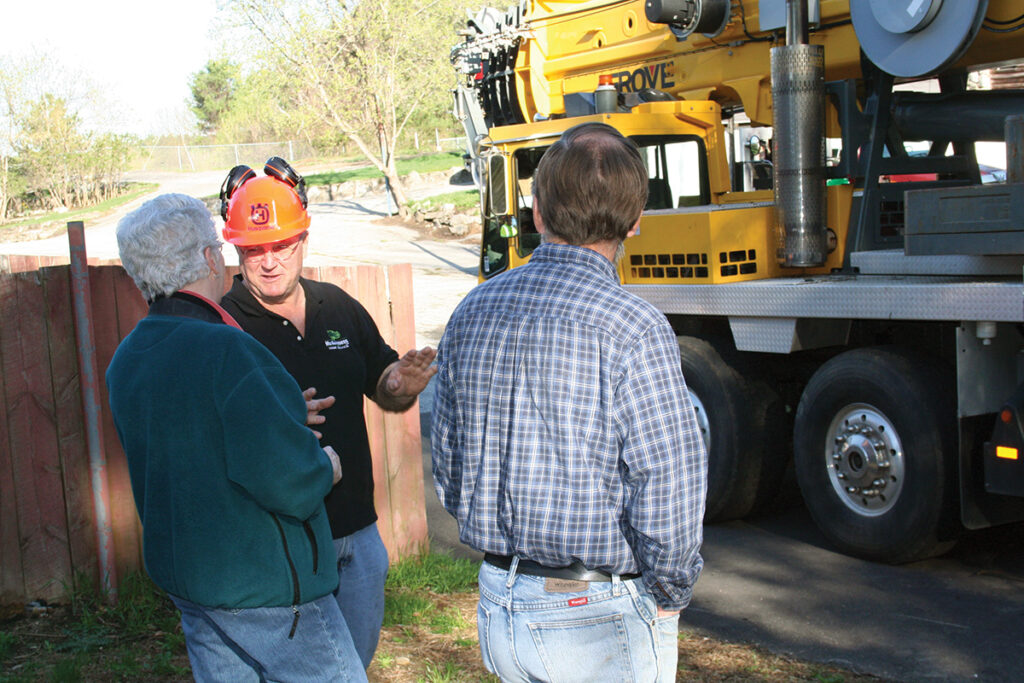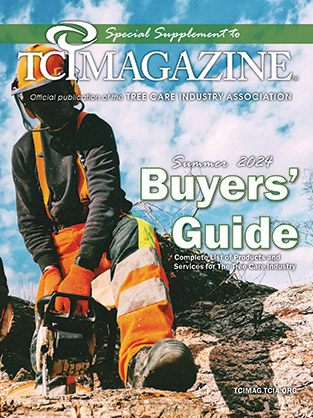Business of Plant Health Care, Part 10: Marketing and Selling PHC Contracts

To this point in our series, we’ve discussed the components of a plant-health-care program – the science, training, credentials and more. In this article, we’ll zero in on the business of marketing and selling PHC.
According to those spoken with for this article and for previous parts of this series, marketing and selling PHC is similar in many ways to selling almost anything – you need to convey the value of the product and services you offer. You do this by being knowledgeable, communicating this knowledge well, being trustworthy and providing top-notch service. And, as with all sales, it is a numbers game.
“Selling PHC is tricky, but there are many approaches,” says Chris Kemp, plant-health-care manager with Piscataqua Landscaping & Tree Service, an 11-year TCIA member company based in Eliot, Maine. “Educating the client is important – the more knowledge they have about their property, the easier it is to get them to agree with PHC proposals. Relationships with the client go a long way, too. Building trust with clients also ensures sales of PHC services.”
People skills
“The person I call the ‘scout’ is the person who goes out to the property on a regular basis and interacts with the client,” says John Ball, Ph.D., BCMA, CTSP and professor of forestry at South Dakota State University. “The most important skill that person needs to have is people skills. And you’d better know every plant – if you don’t know your patient, how are you going to heal them? I can teach you the rest. Heading up your PHC program with an entomologist who hates people isn’t going to work.
“The two rules I have for my scouts are etiquette – always call the client ‘Mr.’ or ‘Ms.’ by name – and always call their plants by name,” says Ball. “That always impresses the customers.”
“Finding workers in our industry can be arduous, but PHC requires building relationships with the consumer, and I always say it’s our duty to create lasting client relationships,” says Kathy Glassey, director of renewable resources for Monster Tree Service, an 11-year TCIA member company based in Fort Washington, Pennsylvania. “We want to be the first person a homeowner calls when something looks wrong, and to do this, building relationships and developing those skills are critical.”
“We get our clients more involved with their tree patients by having them name their trees,” says Tammy Kovar, owner of Biological Tree Services, a nine-year TCIA member company based in Sarasota, Florida. “I find my clients become much more connected to their trees when they are named. We educate our clients every opportunity we can. This leads to referrals.”
Knowledge
“Anyone with the appropriate credentials can sell PHC – credentials are key arborist certifications,” says Kemp. “The greater knowledge level and more training, the better. PHC work is detective work. Know your plants, know abiotic and biotic plant problems. Provide these skills through use of in-field training, workshops, study guides and online material.”
“In an established PHC company, there are arborist salespeople who are technically specialized in identifying and solving landscape issues, and there are technicians who provide the recommended treatments. In a PHC startup, that luxury of role differentiation is not often possible,” says Rob Gorden, director of urban forestry & business development, Arborjet, Inc., a 20-year TCIA corporate member company based in Woburn, Massachusetts.
Business of PHC Series at a Glance
This is the ninth article in a planned 12-part series called Business of PHC that will run in TCI over the next year, focusing on what a smaller company needs to know to launch a plant-health-care program and start offering PHC services. The various aspects of this lucrative profit center that we have covered or plan to cover include:
- PHC – It Could Be the Shot in the Arm Your Company Needs [TCI, April 2021]
- Elements of a Plant-Health-Care Business Plan [TCI, May 2021]
- How to Equip Your Business Without Breaking the Bank [TCI, June 2021]
- What people will you need? [TCI, July 2021]
- The science: Host species and the things that affect them. Get to know the trees in your area and their problems. Understand treatment selection. [TCI, August 2021]
- Diagnosing pest/abiotic problems [TCI, September]
- Simple soil science/use of soil amendments [TCI, October]
- Structural pruning [TCI, November]
- Licensing and regulatory requirements [TCI, December]
- Marketing/selling PHC contracts
- Scheduling/fulfilling PHC contracts [Scheduled for March 2022]
- PHC resources – TCIA PHC Technician, soil-testing labs, pest-diagnostic services, etc. [Scheduled for April 2022]
“The first hire must have the flexibility and skills to do both selling and servicing, but even more important, that person must have the attributes to imagine what is possible on a landscape, a willingness to implement the client’s vision and the skill to apply the recommended steps to protect, preserve and enhance the property,” says Gorden. “That first person hired must view the new market opportunity as if it is their own business,” he says, adding that they must be generously rewarded for their sales growth, customer retention and productivity.
According to Kemp, to effectively sell PHC:
- know your plant ID;
- know common plant problems for your common woody-plant species;
- know common abiotic disorders (drought, winter burn, symptoms of root damage via girdling roots, compaction, etc.);
- have a common knowledge of soils; and
- stay informed about invasive pests, which includes invasive plants.
“Remember, when asked about something beyond your comfort zone, it’s best to collect a sample and let the client know you have some thoughts, but you will double check and get back to them,” says Steve Martinko, owner of Contender’s Tree & Lawn Specialists, a three-year TCIA member company based in Waterford, Michigan, and owner of Banner Sales and Consulting, Inc., a new TCIA corporate member company providing PHC products, based in Novi, Mich. “People appreciate an honest working relationship, and that is one of the best ways you can build trust.”
“Find product vendors who don’t simply sell, but consult as well,” says Jon Welch, president of Crawford Tree & Landscape, an accredited, 43-year member company based in Milwaukee, Wisconsin. “Welcome their expertise and utilize their resources. This partnership is invaluable, as it sets you up not just to buy product, but to receive education in its use, the equipment required and the best practices surrounding application. It’s in their best interest to see you succeed, right? When you sell, they sell!”
Communication
“Your clients have to understand what you are doing, why you are doing it and what to expect. Client communication is key!” says Kemp. “You need to have a dialog with the client.”
“When proposing pest, disease or remediation treatments to clients, it’s important to avoid using highly technical terms,” says Gorden. “There’s no question you’ll do better selling a new PHC service to clients when you speak to them on their level. It’s also important that we listen to our customers before sharing our solutions. Take a systemic approach, asking the right questions to get the answers you need in order to write a prescription for their trees.”
“You should prepare your message beforehand,” says Jon Welch. “Not only your content, but your ‘message.’
“Approach existing clients in person or, if you must, on the phone,” adds Welch. “Remember, this is a new service to you, so it will surely be a new concept to them. Not only must they understand, they must see value in your PHC offerings, and enough value to commit. You will not have a high closing rate using a flyer or a brochure, and besides, you and your team will need the reps!
“A written description of your PHC program and services is helpful, and not just for your clients,” says Welch. “The exercise of outlining expectations on paper will help you articulate your message when in front of a new or existing client in person. Photos of plant afflictions to create awareness help, and of application results as well. But most important, educate them on the dollar value, aside from the biological and aesthetic value. That is a message you’ll have to create for your individual market.”
Services
Adding PHC to your service offerings doesn’t necessarily mean that pesticide application is the first step.
“A small company could start by offering organic fertilizer, which isn’t regulated,” says Zack Shier, plant-health-care manager for Joseph Tree Service, an accredited, nine-year TCIA member company based in Dublin, Ohio. “Then you can expand to include the most obvious pest issues in your area, get good at managing them and grow your PHC business from there.”
“You already have the client base,” says Phil Perron, plant-health-care director for Barrett Tree Service East, Inc., an accredited, nine-year TCIA member company based in Medford, Mass. “So you can approach clients with the concept of ‘tree preservation.’ I can go on a client’s property and see a specimen tree, like an old beech that’s not doing so great, and say, ‘I can do XYZ, and you’ll get another five to seven years from that tree.”
Perron warns that the sales arborist has to have confidence that their company’s PHC team can deliver on what they’re promising as they walk the client around the yard. “Start small,” says Perron. “Offer something as simple as soil testing, and maybe even offer it for free to get your foot in the door. Then get the client on a bio stimulant or a fertilizer, and you’re on your way.”
“Soil management is one of the best things you can offer your clients,” says Patrick Anderson, arborologist for Rainbow Ecoscience, a 23-year TCIA corporate member based in Minnetonka, Minnesota. “It can be a great opportunity. If someone calls for a pruning, they obviously care about that tree, so fertilizing it can be an easy sell.
“It might start with taking a soil sample for analysis,” Anderson adds. “If you’re seeing any abnormal leaf color and stunted leaf or twig growth, you’ll want to test the soil. In general, you’ll find trends of what soils are in your service area, and that will dictate the products you’ll want to use. You might even want to follow up a year later (with another soil test) to see how you’re doing.”
“In some cases, a single pruning cut can save a tree from catastrophic failure later in life. How many other PHC practices can make that claim?” poses Christopher J. Luley, Ph.D., a consulting arborist and tree pathologist with Urban Forest Diagnostics, LLC, located in Naples, New York. “So, why is it such a hard sell to clients and, to some degree, arborists?
“PHC structural pruning is an often-ignored service, because clients may not see the need and arborists are reluctant to sell the pruning,” says Luley. “Yet, it is often desperately needed on maturing trees in the landscape, and can save or extend the useful life of many trees by eliminating life-ending failures.”
“We added air-knife and landscape work to the mix in 2010,” says Kovar. “The air-knife work supported our overall theme of tree preservation. Builders, site developers and the City of Sarasota sought our expertise and support.
“Our tree preservation is highly profitable,” says Kovar. “Our niche has surprised us. We have a tree-preservation template I created to support builders, new homeowners and the like. This template assists us through the process.”
Landing the sale
There are two ways to grow a business: selling to more clients, or selling more to current and past clients.
“I recommend targeting clients you already have good relationships with. They’ll be more patient as you’re getting your PHC services off the ground,” suggests Joseph Eves, owner of TCIA-
accredited Coastal Tree Care in San Diego, California.
“First, market to your past clients, who hopefully are happy with your services, to see if they’d be interested in plant health care,” says Shier. “With new software and websites designed for emailing large numbers of people, as well as the Gmail-based, mass-emailing system called GMass, you can reach past clients you hopefully have emails for, or at least addresses and phone numbers.”
John Ball has a different take. “Refine your services with new customers. The last thing you want is to roll out a new program and have it fail with existing customers,” says Ball. “But that doesn’t mean you don’t eventually roll over these services to your existing clientele.”
Regardless of whether the clients are new or existing, show up to the client’s property with all of the necessary PPE: hard hats, chocks, cones, etc. This level of professionalism sets the business apart. “Neighbors often notice when work is being done, especially if there are chemicals involved, and will notice the professionalism of a crew that shows up with all the right safety tools,” notes Perron. “This could encourage conversations that lead to landing a sale.”
Numbers game
“Sales will be easier during a time of rapid economic expansion coupled with many homeowners who are still working from home,” says Steve Martinko. “Large company or small, it all comes down to rolling out a plan that focuses sales on your team’s strengths, so reputations are not adversely affected. No one says you must know everything.”
“BTS started in 2004 after four hurricanes came through Florida,” says Kovar. “We began tree preservation work on live oaks with a soil-injection cocktail of mycorrhiza, beneficial helper bacteria, trichoderma and soil surfactants. Our clients were all referrals from landscapers, arborists, homebuilders and prior clients. As time passed, our referrals grew to include farm and garden stores, University of Florida Extension and city arborists. Our work was spotlighted in the local media, including newspaper and TV, and through local garden clubs. I truly feel like our media exposure set us in a very good direction.”
“You need to keep plant health care front and center with your sales staff. Don’t let it get sidelined,” says Patrick Anderson. “That’s where we see new PHC programs go wrong. Your sales staff is used to selling pruning, but they’re not always thinking plant health care. So make sure it’s at the forefront of your weekly sales meeting.”
Top selling points, according to Chris Kemp, include:
- Don’t make up problems to treat – some properties don’t require any treatments.
- Customize a package for each client.
- Overpromising and not being able to deliver is the worst for your reputation.
- Tree preservation will generate more income than tree removal.
Start slowly! Educate the client – pesticides are bad. PHC involves limited pesticide use, and there are effective organics (horticultural oil) and non-pesticide controls that improve soil health with specialized soil injections.
“PHC can be sold all year!” says Kemp. “But the most effective way to sell is when pests are active on your plants. Your initial sales will sometimes be reactive. Some pest problems are recurring – this makes it easier to sell a seasonal contract or program.”
“Regardless of budget, you usually can find something in the PHC realm to help (your past or existing clients), even if it’s just a small, annual fertilization,” says Zack Shier. “The next step is to add PHC to everything you normally do to grow your clientele base: flyers, door hangers, mailers, business cards, website, email, etcetera. You need to make sure your entire company brand shows you do PHC as well as tree pruning and removals.
“PHC should never be, ‘Oh wait, by the way, do you want this?’ It should be incorporated into the whole business, as if every job should have both pruning and PHC on the estimate,” notes Shier, adding that it’s important to realize PHC growth doesn’t happen overnight, but that it should be consistently managed and worked at until it becomes a successful program.
“Create services that hit different price points and that offer remedy flexibility,” says Welch. “Don’t aggressively fertilize a tree you regularly prune away from the chimney, but still inject a soil-
amendment product to improve the soil condition for that tree. Make it so that PHC is part of all you do, almost a non-negotiable; the sales arborist then simply needs to pick the responsible treatment from a service list.
“Keep the services separate and clearly defined, make the invoicing of each service simple, be realistic when evaluating time on site and be sure to include travel and the prep required each morning and afternoon,” he adds.
“Sell it year-round, then execute when appropriate, package it with all pruning and not in an a-la-carte fashion and don’t wait for clients to ask for it,” Welch concludes. “Think of it this way; when you buy new tires, mounting and balancing them is assumed, and rightly so. Establish PHC that way in the mind of your team and clients as well.”




